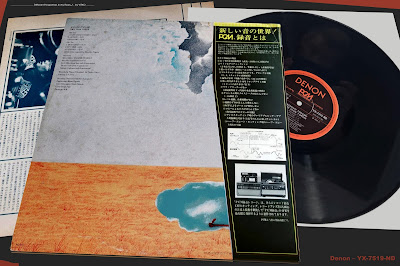Label: Denon – YX-7519-ND
Format: Vinyl, LP / Country: Japan / Released: Jul 1978
Style: Free Jazz, Free Improvisation
Recorded on 2-3 February 1978, at Nippon Columbia's 1st Studio, Tokyo.
Japanese Original Press
Illustration [Cover] – Shozo Shinoda
Design [Cover] – Sign
Engineer – Masao Hayashi
Recording Supervisor – Yoshiharu Kawaguchi
Translated By [Poems] – Tom Oshidari
Composed By – Masahiko Togashi
Matrix / Runout (Side A, etched): YX-7519-ND – A
Matrix / Runout (Side B, etched): YX-7519-ND – B
side 1: A1 -
Voice From Yonder ..........................................................................................
13:40 A2 -
Silence ...............................................................................................................
2:20 A3 -
Welcome ............................................................................................................
3:01 side 2: B1 -
Travelers ..........................................................................................................
12:13 B2 -
It's Time .............................................................................................................
3:34 B3 -
Farewell .............................................................................................................
2:35 Personnel: Masahiko Togashi – percussion
Yoshiaki Fujikawa – reed, percussion
Takashi Kako – piano, percussion
Keiki Midorikawa – bass, cello, percussion
Note: Recorded on 2-3 February 1978.
Production date on the record label says June 1978.
Production date on the sleeve says July 1978.
Liner notes (Japanese) written in May 1978.
Backside of the sleeve listed Personel as Masahiko Togashi Quartet. The album however is published with Masahiko Togashi as artist.
Masahiko Togashi (富樫 雅彦, Togashi Masahiko), March 22, 1940, Tokyo - August 22, 2007, Kanagawa) was a Japanese jazz percussionist and composer.
Togashi grew up in a musical household; his father was a double-bassist in a swing jazz ensemble, and Togashi learned violin and drums, playing the latter in his father's band. He worked with Sadao Watanabe, Toshiko Akiyoshi, and Tony Scott in the 1950s, then founded the ensemble Jazz Academy in 1961 with Hideto Kanai, Masabumi Kikuchi, and Masayuki Takayanagi. He was an early free jazz leader in Japan, playing in this idiom with Yosuke Yamashita and performing with American musicians such as Ornette Coleman, Blue Mitchell, Lee Morgan, and Sonny Rollins on Japanese tours.
Togashi lost the use of his legs in an accident in 1969, and designed a new kit that would allow him to continue playing. Togashi’s technical expertise on a wide range of percussion instruments allows him to introduce into his performances telling effects that add intriguingly exotic undertones.
Later associations included performing or recording with Paul Bley, Don Cherry, Jack DeJohnette, Charlie Haden, Steve Lacy, Gary Peacock, Masahiko Sato, and Yuji Takahashi.
If you find it, buy this album!


























